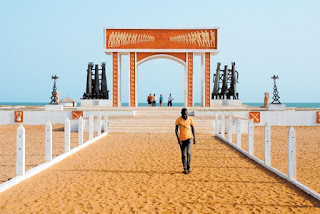Ouidah
The Portuguese Fort of Ouidah in 1886
Ouidah , was once known as Juda, a city in Benin , it is located 42
kilometers from Cotonou . The population is currently at about 60,000
inhabitants . In the eighteenth century, this city was one of the main centers
of the abduction and transport of slaves in the Transatlantic Slave Trade.
Quidah was the main place to transport the slaves to the Americas, From the
eleven million Africans taken by Western Slave Traffickers almost two million
left from Benin. 60 percent from the two main ports Quidah and Lagos. Quidah
was strategically isolated from the rest of the kingdom to guarantee the royal
monopoly. The Yovoghan, which translate to "leader of the Whites" was
the commercial interface between European slavers and the Abomey slave state.
This was set up by King Agadja of Agbomin (1708-1740), the slave trade was set
up by King Kpengla (1774-1789) and was undertaken by periodic raids on the
margins of the kingdom to the benefit of the ethnic groups of Fons. The slaves
were assembled in a square to be sold, then chain together and taken to the
beach to be separated. They were then put in canoes, taken to the ships
andplaced in holds as they awaited the voyage to the Americas. Many slaves
convinced they were to be eaten threw themselves into the sea.
Quidah was the main port for export of the slaves, Many European countries,
such as the Danish, Portuguese, Dutch, French and the English came there to
capture or trade for slaves. The Kings and elite tribes bartered with the Europeans
to obtain the best price for their human commerce. In Benin today, the history
of the slave trade by the Abomey kingom has fostered tension between the Fons
and the ethnic tribes that live further north that fell victim to the annual
raids carried out at that time condemning many of their ancestors into slavery.
Quidah is home to many monuments:
The Whydah Galley
A model of the Whydah Galley
Whydah was commissioned in 1715 in London, England, by Sir Humphrey Morice,
a member of the British Parliament, known as 'the foremost London Slave
merchant of his day'.A square-rigged three-masted galley ship, it measured 110
feet (34 m) in length, with a tonnage rating at 300 tuns burthen, and could
travel at speeds up to 13 knots (24 km/h; 15 mph).
Christened Whydah after the West African slave trading kingdom of Ouidah
(pronounced WIH-dah), the vessel was configured as a heavily armed trading and
transport ship which included the Atlantic slave trade. It set out for its
maiden voyage in early 1716, carrying a variety of goods from different
businesses to exchange for delivery, trade, and slaves in West Africa. After
traveling down West Africa through modern-day Gambia and Senegal to Nigeria and
Benin, where its namesake port was located, it left Africa with an estimated
500 captives,gold, including Akan jewelry, and ivory aboard. It traveled to the
Caribbean, where it traded and sold the cargo and captives for precious metals,
sugar, indigo, rum, logwood, pimento, ginger, and medicinal ingredients, which
were to then be transported back to England.Fitted with a standard complement
of 18 six-pound cannon, which could be increased to a total of 28 in time of
war.
On the return leg of its maiden voyage of the triangle trade, it began a
new role in the Golden Age of Piracy, when it was captured by the pirate
Captain Samuel "Black Sam" Bellamy, and was refitted as his flagship.
Bellamy sailed the Whydah up the coast of Colonial America, capturing ships
as he went. On April 26, 1717, the Whydah was caught in a violent storm and
wrecked. Only two of Bellamy's crew survived, along with seven others who were
on a sloop captured by Bellamy earlier that day. Six of the nine survivors were
hanged, two who had been forced into piracy were freed, and one Indian crewman
was sold into slavery.
Whydah and her treasure eluded discovery for over 260 years until 1984,
when the wreck was found – buried between 10 and 50 feet of sand, under water
depths of 16 to 30 feet deep, spread four miles parallel to the Cape's coast.
With the discovery of the ship's bell in 1985 and a small brass placard in
2013, both inscribed with the ship's name and maiden voyage date, Whydah is the
only fully authenticated Golden Age pirate shipwreck ever discovered.
*Source: Wikipedia
"The Door of No Return"
La Porte Du Non Retour is a monument that was built in the design of a gate.
It is the symbolism of the departure of captured slaves leaving for the
Western world from Benin. It was the
last place slaves walked before they were taken to the slave ship; the slaves
knew from that point that they wouldn’t be able to ever see their familes or
Benin again.




I WILL RETURN .
ReplyDelete